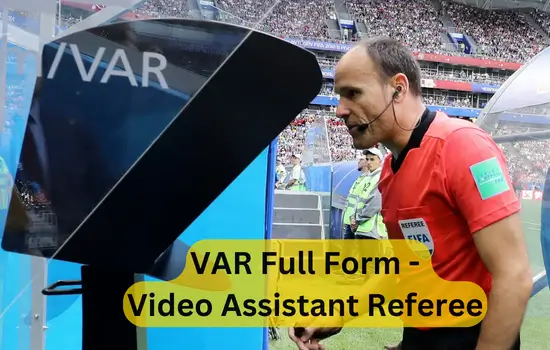In the ever-evolving world of football, innovations are continually introduced to ensure the integrity and fairness of the game. One such groundbreaking addition to the sport is the Video Assistant Referee (VAR) system. This technological marvel has sparked debates, controversies, and significant changes in the way football matches are officiated. In this comprehensive exploration, we delve into the VAR system, understanding its full form, its inception, and its impact on the beautiful game.

Quick Overview
- VAR: Video Assistant Referee
- Introduced to enhance officiating in football matches
- Utilizes video technology to review and correct decisions
- Aims to minimize errors and ensure fair play
- Implemented in various football leagues worldwide
The Genesis of VAR
Emergence of Video Technology
The idea of incorporating video technology in football officiating gained momentum in the late 20th century. The increasing complexity of the game and the high stakes involved led football authorities to explore ways to reduce errors in decision-making. The advent of high-definition cameras and instant replay technology paved the way for a system that could review critical moments in real-time.
Initial Experiments and Trials
Before the official introduction of VAR, several experiments and trials took place to assess its feasibility and effectiveness. These trials occurred in various competitions and friendly matches, allowing football authorities to fine-tune the technology and address potential challenges. The initial response from these trials played a crucial role in shaping the VAR system that we witness today.
Decoding VAR: The Full Form
Video Assistant Referee Unveiled
VAR stands for Video Assistant Referee. It is a system designed to assist on-field referees in making critical decisions during a football match. The VAR team consists of trained officials who use video footage and technology to review decisions made by the on-field referee. The primary objective is to correct clear and obvious errors related to goals, penalty decisions, direct red card incidents, and cases of mistaken identity.
How VAR Works
- On-Field Decision: The on-field referee makes a decision during the course of the match.
- VAR Review: If there is a contentious decision, the VAR team reviews the footage from various camera angles to assess the accuracy of the on-field decision.
- Communication: The VAR communicates with the on-field referee through a headset, providing insights and recommendations based on the video review.
- Decision Correction: The on-field referee has the option to either uphold the original decision or make the necessary correction based on the information provided by the VAR.
VAR Protocols and Guidelines
VAR operates under specific protocols and guidelines established by football governing bodies, such as FIFA and UEFA. These guidelines define the situations in which VAR can intervene and the criteria for decision review. The goal is to maintain consistency and fairness across different matches and competitions.
VAR Impact: Revolutionizing Officiating
Reducing Errors and Controversies
The introduction of VAR has significantly contributed to reducing errors and controversies in football matches. The ability to review crucial moments with the help of technology has minimized instances of incorrect goal decisions, wrongly awarded penalties, and mistaken identity in red card incidents.
Fair Play and Integrity
VAR plays a pivotal role in upholding the principles of fair play and integrity in football. By ensuring that key decisions are thoroughly reviewed and corrected when necessary, the system contributes to a more level playing field for all teams.
Challenges and Criticisms
While VAR has brought about positive changes, it has not been without its share of challenges and criticisms. Delays in decision-making, subjective interpretation of incidents, and concerns about the impact on the flow of the game are among the issues raised by critics. Continuous refinement and adaptation of VAR protocols aim to address these challenges and enhance the system’s overall effectiveness.
Conclusion: VAR in the Future of Football
As football continues to evolve, VAR remains a central figure in the ongoing efforts to enhance officiating and maintain the sport’s integrity. The system’s journey from conceptualization to global implementation reflects a commitment to leveraging technology for the betterment of the game. As VAR protocols are fine-tuned and football authorities work to address criticisms, the future promises a more refined and seamlessly integrated Video Assistant Referee system, further solidifying its place in the modern football landscape.

Hello, I’m Kapil Kumar, a seasoned SEO expert and blogger at WinnersList.in. My mission is to spotlight exceptional individuals and organizations across various domains. Through curated lists, profiles, and inspiring stories, I aim to celebrate outstanding achievements and inspire the next generation of champions. Join me in this journey.
